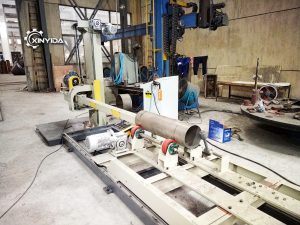Polishing tubes, whether for aesthetic or functional purposes, is a vital process in various industries, including automotive, aerospace, and manufacturing. For beginners stepping into this field, selecting the right polishing machine can make a significant difference in achieving high-quality finishes while ensuring ease of use. In this article, we’ll explore the types of tube polishing machines suitable for beginners, discuss the advantages of using an orbital polisher, and clarify the pros and cons of rotary polishers.
Understanding Tube Polishing Machines
Tube polishing machines come in various forms, each designed for specific applications and levels of expertise. For beginners, it’s essential to choose a machine that balances functionality with ease of use to promote a smooth learning curve.
Types of Tube Polishing Machines
- Orbital Polishers
- Rotary Polishers
- Belt Polishers
- Bench Polishers
Orbital Polishers: A Beginner-Friendly Option
What is an Orbital Polisher?
An orbital polisher is a versatile tool that utilizes a random orbital motion, combining both circular and back-and-forth movements. This action helps reduce swirl marks and achieves a more uniform finish, making it an excellent choice for beginners.
Advantages of Using an Orbital Polisher
- Ease of Use: The random orbit motion reduces the chances of damaging the surface, making it forgiving for novice users.
- Versatility: Orbital polishers can be used on various surfaces, including metal, plastic, and paint, allowing beginners to experiment with different materials.
- Reduced Risk of Burn Through: Because the pad moves in multiple directions, there’s less risk of overheating and damaging the workpiece—a common concern for beginners.
- Lightweight and Maneuverable: Most orbital polishers are designed to be easy to handle, making them suitable for extended use without fatigue.
Is an Orbital Polisher Suitable for Beginners?
Yes, absolutely! An orbital polisher is ideal for beginners due to its user-friendly design and forgiving nature. It allows newcomers to practice their polishing skills without the steep learning curve associated with more advanced machines.
Rotary Polishers: The Power Tool
What is a Rotary Polisher?
A rotary polisher operates by spinning the polishing pad in a consistent circular motion. While this technique can deliver excellent results, it requires a bit more skill and experience than an orbital polisher.
Advantages of Using a Rotary Polisher
- Powerful Performance: Rotary polishers offer faster material removal and can achieve a high-gloss finish when used correctly.
- Suitable for Experienced Users: These machines are often preferred by professionals who require precise control over the polishing process.
Can You Polish with a Rotary Polisher?
Yes, you can polish with a rotary polisher, but it’s essential to approach it with caution as a beginner. The constant speed can generate heat quickly, which may lead to burn-through if not handled properly. Therefore, beginners should practice on less visible areas or scrap materials to build confidence before moving on to more critical projects.
Other Options for Beginners
Belt Polishers
Belt polishers are another option for beginners. They use a continuous belt to polish surfaces and are especially effective for removing heavy scratches and imperfections. However, they require a certain level of skill to operate effectively, making them slightly less suitable for absolute beginners.
Bench Polishers
Bench polishers are stationary machines ideal for small-scale operations. While they provide stability and precision, they might not be the best choice for beginners looking to learn mobility and handling.
Best Practices for Beginners
Once you’ve chosen your polishing machine, here are some best practices to keep in mind:
1. Start Slow
Don’t rush the process. Begin at a lower speed setting to get a feel for the machine. As you gain confidence, you can gradually increase the speed.
2. Use the Right Polishing Pads
Different materials and finishes require specific pads. Ensure you select the appropriate pad for the material you are polishing to achieve the best results.
3. Practice on Scrap Material
Before working on your primary piece, practice on scrap tubes or less valuable items. This will help you understand how the machine operates and how to achieve your desired finish.
4. Maintain Your Equipment
Regular maintenance is crucial for any polishing machine. Clean the pads and check for wear and tear to ensure optimal performance.
5. Wear Safety Gear
Always prioritize safety. Use goggles, gloves, and masks to protect yourself from dust and debris generated during the polishing process.
Conclusion
For beginners entering the world of tube polishing, selecting the right machine can significantly impact the learning experience and overall results. Orbital polishers are highly recommended due to their ease of use and flexibility, making them perfect for those just starting. While rotary polishers can deliver exceptional results, they require a bit more skill and caution.
By understanding the differences between these tools and following best practices, beginners can confidently embark on their tube polishing journey. With patience and practice, anyone can achieve professional-quality finishes, paving the way for future advancements in their polishing skills. Whether you’re polishing stainless steel, aluminum, or brass, the right equipment and techniques will set you up for success in your polishing endeavors.

